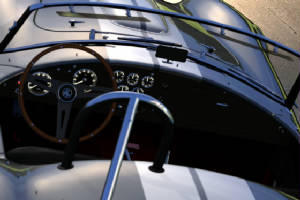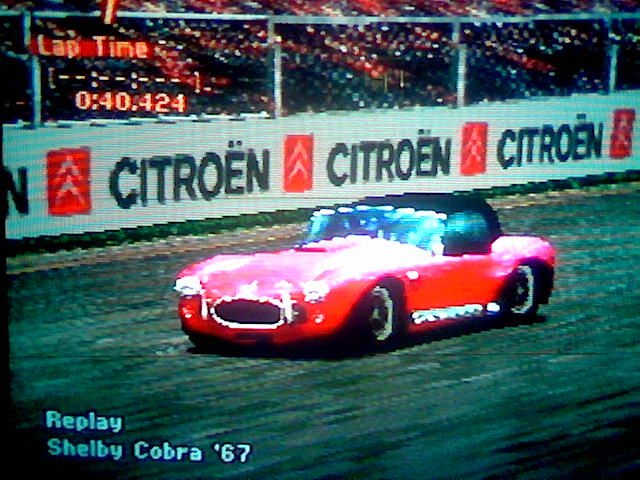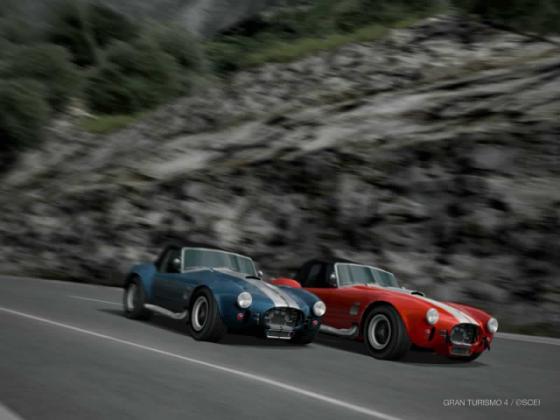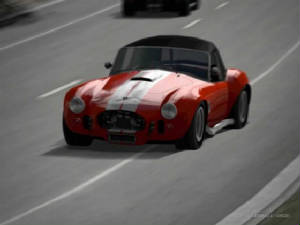|
SPECS
Years Represented: 1965-1967
Country: UK & USA
Class: Sports Car
Type: 2-door roadster
Host: GT2, GT3, GT4 & GT5
Price: 300,000 (GT2--memory card trade after prize)
``````````500,000 (GT3)
``````````423,200
(GT4, AC Cars 427 S/C)
``````````530,540 (GT4, Shelby Cobra 427)
``````````(GT5, Shelby Cobra 427)
All
specs & testing currently for the Shelbys
Construction: fiberglass body, steel frame chassis
Length: 166.0"
// Width: 68.0" // Height: 49.0"
Wheelbase: 90.0"
Overhang: 5 feet 6 inches
Track: 55.0" front & rear
Ground
clearance: 4.9"
Weight: 2,354 lbs.
Layout: Front Engine / Rear Drive
Tires: 185x15 [F] 195x15 [R]
F. Suspension:
unequal length A-arms / coils / anti-roll bar
R. Suspension: live axle / A-arms / coils / anti-roll bar
Brakes: Girling
discs
Engine: 427 cubic inch OHV V8
Aspiration: natural
GT2 horsepower:
429 @ 6,400 rpm
GT2 Torque: 434
@ 3,500 rpm
GT3 horsepower: 509 @ 6,500 rpm (oil changed)
GT3 Torque
495 @ 3,500 rpm
GT4 horsepower: 485 @ 6,500 rpm (no oil change)
GT4 Torque:
480 @ 3,500
GT5 horsepower: 470 @ 6,500 (no oil or break-in)
GT5 Torque: : 465
@ 3,500
Credits per HP: 699.30 (GT2) // 982.32 (GT3) // 1,093.91 (GT4)
Lbs. per HP: 5.49 (GT2) // 4.62
(GT3) // 4.85 (GT4) // 5.01 (GT5)
Hp per Liter: 61.3 (GT2) // 72.75 (GT3) // 67.2 (GT5)
Fuel System: single Holley
4-barrel
Valves per Cyl: 2
BorexStroke: 4.24 x 3.79"
Compression Ratio: 10.5:1-11.5:1
GT4 & 5 Idle
Speed: 750
Redline (all games): 6,500 // RPM Limit: 7,000
Transmission: 4-speed manual
Differential: limited-slip
0-60 mph:
GT2: 5.178 seconds
GT3: 4.883
GT4: 4.750
GT5: 5.450
0-100 mph:
GT2: 10.116 seconds
GT3: 8.966
GT4: 8.850
GT5: 9.100
0-150 mph:
18.133 (GT4)
18.300 (GT5)
400 Meters:
GT2: 12.988 @ 120 mph
GT3: 12.744
@ 124.6
GT4: 13.202 @ 126.x
1 KM:
GT2: 23.406 @ 136
mph
GT3: 22.573 @ ? mph
GT4: 22.168 @ 154
100-zero mph: 4.25 seconds (GT4) 5.266 (GT5)
Test Track:
1:50.939 (GT2)
Top Gear RPM @ 60 mph: 2,700 (GT4 & 5)
Top Speed at Redline (GT3)
1st: ?
2nd: 75.1 mph
3rd: 102.0 mph
4th: 137.93 mph
@ 7,000 rpms (GT2, tach/gear limited))
135.2 mph
@ 7,000 rpms (GT3)
Top Speed at Redline (GT4)
1st: 59 mph
2nd: 85 mph
3rd: 111 mph
4th: 154.27 mph @ 7,000 rpms
(tach/gearing limited)
Top Speed at Redline (GT5)
1st: 64 mph
2nd: 88
3rd: 114
4th:
154 mph @ 7,000 rpm (tach/gearing limited)

-------------------EXTERIOR / HISTORY----------------------
Ready to drive a car that lives up to its name and then some?? Why exactly did Shelby
name his pet project car after a sly, wiry snake? Was it just a cool name or is there more to the story? Well if you've
ever handled a live snake of any kind, you'll know that when they're nervous, snakes do their best to squirm and out-maneuver
your fingers. And trust me, so will this car. They also sometimes have a nasty, poisonous bite. So does this
car.
At first glance, the Cobra seems to have it all: looks, power, speed, a lightweight platform ...but, it is (in
several ways) not too much different from a powerful yet clumsy American muscle car. I do give it a 10 out of
10 for its good looks, tho. Let's learn a few facts.
... Chances are if you've been driving or riding American highways for many miles, you may
have eventually seen a Cobra, especially if you live in California. But what you saw most likely wasn't real; numerous replicas
and kit cars are out there cruising around. There were only a total of about 400 real Shelby Cobras made back in the '60s.
Carroll Shelby was at the helm of this operation back in these days, which is an interesting story to tell...
In his day, engineer/designer/racecar-driver Carroll Shelby was highly regarded. Before race-driving, it seemed
as if he were a bit lost (like many of us are). He got out of the U.S. Air Force after World War II ended,
then tried running a dump truck business. Towards the end of the '40s, he then became a chicken farmer
(imagine that!). He made an early profit, but his second coop of chickens all died of some disease.
In 1952,
he somehow got involved in his first drag race at the age of 30, driving a Flathead Ford. From that humble beginning,
Shelby really took off, eventually driving sports cars, rally cars, and Formula 1. For his first road
race, he drove an MG-TC against stronger Jaguar XK-120s, and beat them.
Though his driving record wasn't all
wins, there were some notable achievments. Competing (and winning) against the likes of Phil Hill, for instance.
Shelby broke his arm during some race, yet managed to drive Sebring not long afterwards with his arm slung in a
fiberglass cast, his hand taped to the steering wheel! He also set a string of records at the Bonneville salt flats in the
mid-50s while driving for Austin-Healy, and competed at Le Mans. His final racing season went with a bang. This would
have been in 1961. Carroll won the USAC Championship driving a Maserati.
However, sometime during 1960 Carroll
was in the process of being done with racing due to health issues. Not that this slowed him down much; he simply
got involved in more projects!
Most folks don't know that the car the Cobra was originally based on was not made by
Shelby; but by AC, a British carmaker that eventually died in bankruptcy after Shelby's involvement with AC ended. AC's star
was called the Ace.
AC Aces started off nothing like the ridiculous rockets Shelby later engineered, but they weren't
endowed with great power, either. AC was hungry for some racing wins, which they hoped would help their sales (apparently,
they were having problems before Shelby got involved). AC had a deal with Bristol (another British automotive company),
which would have provided AC some 6-cylinder engines, but this deal fell thru.
At the same time, Shelby was really
wanting to start his own sports car company. He may have noticed AC was having problems, and decided it would be cost-effective
to join forces. AC's cars, after all, were sweet-looking rides.
When Shelby started combining his ideas with
AC, he decided to stuff a 221 cubic-inch Ford V8 small block under the hood. Or
maybe it was a 260. Various sources conflict this information. He initially tried to get Chevrolet involved, but
Chevy didn't want to see Chevy-powered Cobras killing their Corvettes; so Ford was contacted instead. It was Chevy's
loss! Eventually the Cobra wound up kicking the Corvette's ass in the SCCA, and then moving internationally to compete at
Le Mans and countless other FIA events. There's too much information to get into here...suffice it to say Shelby/AC's Cobra
did well with Ford power, and the Corvette couldn't always keep up.
To compete in the FIA's GT class, Shelby was required
to build 100 total Cobras. At first, he is reported as being worried AC wouldn't be able to handle the pressure; just eight
cars had been built at that point! But they got it together. So far as production went, the process was for AC to build
the car, which would get freighted off to Shelby's shop in California, where the engine, transmission, drivetrain,
and other parts would be installed by master-tuner Carroll Shelby. Here (in California) is where the Cobra really
began its full life, a full 30 years before Dodge became obsessed with naming some of their cars after snakes. The Shelby/AC
Cobra had a fully-independent front suspension with a live rear axle, rack & pinion steering, and Carroll had the V8 mounted
somewhat behind the front wheels to preserve the car's balance and weight distribution, just as Mazda has been doing with
their RX-7s.
...But like a true American, Shelby got greedy. Ha ha..just kidding, actually AC and others
involved in the project were just as hungry for wins as Carroll. The 260 was quickly upgraded to the famous 289
to better compete in GT racing, and in 1965, the 427 was introduced, after Shelby & company tweaked the
289 as far as they could with what technology they had available, and found it just wasn't enough. The Cobra (as fast
as it was) initially struggled at some races against Ferrari until the 427 was unleashed.
In GT2, the Cobra 427 is
a prize, and actually there are two versions, since we can also find a Cobra Coupe racing car in this game as well (and dammit,
the Coupe didn't make it to GT4!). We can win the 427 after completing the Muscle Car race at the extended
Seattle track, but I believe the Coupe must be bought.
In GT3 and GT4, Cobras are now for sale, and can
be bought for around half-a-million credits. Though the Cobra cannot be race-modified in GT2, a total of 190 pounds
can be shaved from its body with three weight reductions (more gets removed in the third game...a total of 260). This doesn't
sound like much, but I'd recommend taking this car down to Stage 3 unless you're a competent Gran Turismo driver; it'll just
make the Cobra easier to maneuever, though in the third game it also makes it less stable. Gotta lose somewhere. The Cobras
of GT4 are mostly overkill machines, as we'll discuss in the next section. Weight never needs to be deleted for these.
Though
the 427 Shelby Cobra is a fun car, I personally would have preferred the Cobra with the 289 or one of those small-blocks.
Let's discuss the engine now.

-----------------ENGINE / DRIVETRAIN--------------------
When comparing the 427 engine to the 289, we find the 427 (of course) is endowed with
a lot more power. Though this is not a true "muscle car", it sure behaves like one with this heavy motor, which was made from
a cast-iron block with aluminum heads. It used probably enough metal to make kitchenware for an entire neighborhood!
Shelby
Cobras (as portrayed in GT2 and GT3) are extremely fast,...uh, in the quarter-mile. In almost any other scenario, there's
not much to say. Power sometimes gets wasted during racing situations because the car's handling sucks. The Cobra
also posts a poor run in the 1000 meter-dash in these two games since its 4-speed gearbox runs out of steam shortly after
passing 400 meters. The car in GT4 must have a different gearbox. Both the AC and the Shelby in this game can make it just
past 150 mph, rather than just past 130.
If I owned a Gameshark, one of my first priorities would
be to put the 289 engine that's in the Mustang into the Cobra. Yeah, it only has 306 horsepower, but its lighter weight would
make the Cobra more race-worthy (without negative excess) and not so nose-heavy. The real-life 289 Cobra convertible
had a 51/49 weight distribution (more ideal for a sports car). I'm not sure what distribution a 427-endowed car had,
but you can bet it's definitely got a lot more weight up front.
But as far as power is concerned, do not fret.
:D With full Stage 2 engine parts, the 427 is making 574 horsepower with 541 ft-lbs. of torque
in GT2, which is about all this car can handle to be honest. For another 74,000 credits, Stage 3 parts fixed-in
for even more power. Oddly, this third set of parts is absent from GT3, yet at max we can still welcome some
serious power...740 hp @ 6,900 rpms! Hey there, ho there! GT4 is slightly
less: 709 bhp @ 6,500 and 680 foot-pounds with Stage 3 tuning, or 720 and
842 from a supercharger.
With Stage 2 upgrades + engine balancing come an additional 1,000
RPM on the tachometer (GT2, GT3) or 500 in GT4. Since peak power is located near the redline in all cases, it's a good idea
to get the engine balancing service early on, which will give a good bit of horsepower, too. This extra room on the tach is
also great, since (at times) it's possible to pull some sweet burnouts out of corners...sometimes even in third gear,
so it's a good idea to make sure the rev limiter hasn't got a chance to interfere with these moments of beauty. ;D
But
before we do any of this, what's mandatory is to buy a full-racing gearbox. Without it, the Cobra'll
never be able to top 140 mph in GT2 or 3! GT4's Cobras often won't need this part. Mostly, the races they can compete
in only require 4 speeds and less than 150 mph. The fully-modifiable differential is another good buy in any game, even
before the engine gets upped, as we'll see in the Handling section below.
Finding races in which Cobras can compete
can be difficult, depending which game, because these cars can wind up either becoming cheater machines, or not able to keep
up with traffic. When driven by the Playstation, the Cobra is sometimes the fastest car on the grid.
A lot of Gran
Turismo soundbytes sound the same in my opinion. If you ask me, they didn't really sample all the cars they claim to have
sampled, possibly due to time constraints, as well as locating the actual car they needed. Well, this is not so with the beautiful
gurgle of the 427 that's in this beast! Before I actually tested this car, I just had to sit at the starting line,
listening to it idle! Listening to... those lifters, man. Beautiful.

----------------CHASSIS / HANDLING--------------------
Driving the Shelby Cobra is like playing a big, dumb He-man so far as driveability goes.
Plenty of thrust, plenty of ooomph, but a lack of control, kind of like Conan the Barbarian on a rampage. This car is FAST,
but beware, because it's almost always ready to lose it all due to its clumsiness.
The Cobra is
one of Gran Turismo's specialty cars; not really a necessity to make the game complete (I certainly didn't expect Shelby Cobras
in GT2, and thought for sure they would be cut when GT3 was released). If they had videogames back in the '60s the Cobra
would be one of the top cars to attain, the way a Viper, BMW M-series, or a Skyline GTR is nowadays.
But when we drive it in our game, how does it actually uh....drive?
Let's face it, even if you're not new to the game, even
if you're adept at driving high-powered rear-drive cars with bad handling, you ain't seen nothin yet! How about racing?
Cobras will win races...don't get me wrong, but to make them win reliably?
GT2
Before I raced this car at Special Stage Route 5 on the GT2 Arcade disc, using Stage 2 power with all racing parts, I
expected the Shelby Cobra would handle like a TVR Griffith, but worse. I was expecting lots of tire smoke,
lots of fishtailing, and at least one grandiose, unavoidable spinout in the hairpin. Actually, the reverse is true; the
Cobra in GT2 isn't very tail-happy at all...it's much more prone towards understeer, (unless you're running
on stock tires). Kind of reminds me of the '67 Corvette Stingray, but with less throttle-oversteer.
Even with super-soft
tires, the Cobra just doesn't get a clue. It'll slowly plow towards whatever it is you're trying to avoid. "Hey you dope,
why don't you try using brakes BEFORE we get in the corner if you want me to behave?" the Cobra seems to shout at
us.
GT3
Now
in GT3...I've found the Cobra 427 acts a lot more as I expected so far as oversteer is concerned. Enter most any corner
where brakes are needed, and the sideways dance begins and gets worse, unless those brake and gas buttons
are well-modulated! Even the tiniest tap on the brakes mid-corner can cause a trail-brake slide, forcing one to
dial those rear discs down (assuming a brake-controller is in use). And the throttle?? Woooh...you'd better take all those
TVR lessons and double them!
So. What can we do about all this?
Why not "go with
the flow"?...as they started saying around the time the Cobra was invented. Go for drift! Let it slide around a bit!
Ah yes.
The Cobra's racing line through corners just plain sucks if you're trying to behave with pure grip-racing,
and so will your replay. So keep this one where it seems to want to be: right on the edge! Friction?
Smiction! Like I said, records will rarely be set in a Cobra despite its power. During racing situations the
car'll no doubt need to constantly be tamed, so at times drifting (I'm talking minor drifts & slides, not Tommi Mäkinen
stuff) are a definite answer.
GT4
Now what's interesting is in this game, the Cobra (AC or Shelby) feels the most contained, assuming the
driver isn't a button-mashing type. Any negative driving trait can be avoided quite easily, for those who are more adept.
Brakes are horrendous in this game, yet not the worst I've ever seen, so brake early. But the behavior described in
GT3, where the car would slide with the merest brake-tap mid-corner, simply never happened to me in GT4. Only during extreme
high-speed cornering situations (Nurburgring, for instance) does the Cobra really get squirrely under braking.
There's
a surprising lack of understeer into slower & intermediate corners in this game, but it does show up once the Cobra's
blasting thru a higher-paced curve, throttle or no throttle. The car gets predictably twitchy at times in this game when driven
at full speed, but slow it down, and it does start to behave itself.
Leaving corners? It's just like GT3...LOTS of
issues...all of them stuff we've seen before of course, so easy with that gas-pedal! A lot of this can be tamed with just
a 1 or 1.5-way differential while the car's power is still stock, but anything over Stage 1 will typically require more drastic
measures.
No matter what we do, it's difficult to get a Cobra 427 to behave. If you like poor steering response,
lots of tire-smoke and other such behaviors, this is your car. But personally, I was more interested in the drive
itself, not the actual moment of glory as I whizzed past the finish line and the coked-up business folks watching the race
from their office buildings cheered my vintage roadster on.

PROS---------------------------------------
1).
The engine. It just can't wait to gobble the road. The real-life 427 got 9 miles per gallon on the highway...6 in the city.
This isn't our problem though, unless we're playing GT4.
2). PD got a unique soundbyte for the engine/exhaust, too. Sounds killer.
3). Sweet-looking
car....the kind of car we'd normally see only on stupid college dorm posters with some hot babe in a bikini straddling it.
4).
The unique factor: no other machine like this one in GT. Well, the TVR Griffith comes nearest I guess...
5). A
prize that can be sold in GT2 for easy money after winning one of the Muscle Car races over and over.
6). Lots of fun if
you have the experience to drive the Cobra without the Cobra driving you!
7).
At 2,354 pounds, a stock Cobra 427 is already a lightweight...
8). ...and with less than 6 pounds per horsepower (stock!)
a 120 mph quarter is just a few seconds away.
9). GT4 + 5: both the AC Ace and Shelby Cobra can be
had.
CONS----------------------------------------
1). Nose-heavy handling...the kind of handling one would expect from a big block Pontiac Tempest. Lots of unexpected
understeer. Vague steering, and plenty of oversteer is on tap from throttle and brakes, especially in GT3 or 4.
2).
Stock 4-speed tranny great for ¼ mile runs, horrible for anything else (this isn't as true in GT4 or later versions, which
have taller gearboxes).
3). Tires aren't up to spec for modern GT racing.
4). Poor power-to-pavement efficiency.
Yes, the engine has lots of ‘go’...but mostly you won't be able to use it till you're in a straight line.
5).
Must be won in GT2 (rather than conveniently bought). An expensive choice in GT3 or GT4. We apparently can't win them
in these games.
6). Not a car for beginners or some intermediates.
7). Really poor brake response. Those Girling
discs may have been the cutting-edge technology of the day, but that "day" was 40 years ago.
8). You'll need all the
aftermarket parts you can buy. No, not the engine parts, the suspension parts! ... And brakes.
And limited-slip. And a full-custom transmission in some cases. Get it all before you
top-off that engine.
9). Difficult to competitively race these cars, as they can either wind up being cheaters
(blowing away the field), or unable to keep up with more modern competition that handles its power much more
flawlessly.
Published: May 9th, 2005
GT4 content added: ?
|



